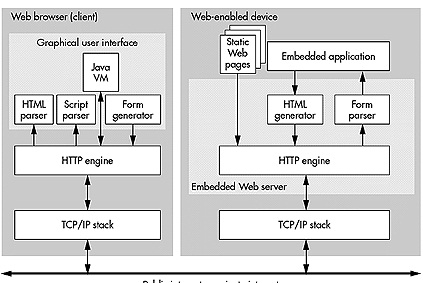





Published on Apr 02, 2024
Embedded Web Technology (EWT) is regarded as the 'marriage' of Web technologies with embedded systems. In other words, the software developed for embedded systems is applied by making use of the Internet.
Embedded technology has been around for a long time and its use has gradually expanded into the PC market. Speed, accuracy, reliability were the reasons why embedded technology entered computers. With an great market size of billions in the next coming years, the future is embedded. Embedded systems contain processors, software, input sensors and output actuators, which work as the controls of a device and are subject to constraints.
These Embedded systems may not have disk drives, keyboards, display devices and are typically restricted in terms of power, memory, GUIs and debugging interfaces.The central building blocks are microcontrollers, i.e. microprocessors integrated with memory units and specific peripherals for the observation and control of these embedded systems.On the other hand, Web technologies employ client-server models.
The embedded Web system works on the same principle as that traditional Web request-response systems. Web pages from the embedded system (server) are transmitted to the Web browser (client) , which implements the user interface (Presentation layer). In other cases , the the embedded system dynamically generates the pages to convey the current state of the device to the user at the centralized location. These end users can also use the Web browser to send the information to the embedded system for the configuration and control ofd the device.
Web-enabled devices use the HTTP (Hyper Text Transfer Protocol) standard protocol to transmit Web pages from the embedded system to the Web browser , and to transmit HTML (Hyper Text Markup Languages) form the data from the browser back to the device. The devices require a network interface such as Ethernet ,TCP/IP software , embedded Web server software , and the Web pages (both static and generated) that make up the device- specific GUI.
The HTTP protocol engine takes the request from the Web browser and sends it on the TCP/IP. The HTTP protocol Engine parses the request and sends it to the embedded application for processing. After producing the results , the embedded application generates the HTML code and feeds it to the HTTP Engine , which sends it back to the client using TCP/IP.

Figure 1: Web-enabled devices use the HTTP standard protocol to transmit Web pages from the embedded system to the Web browser, and to transmit HTML form data from the browser back to the device .
Embedded Web Technology is an enabling, or platform, technology. This means that it is relevant to a wide variety of applications, many of which have not yet been identified. We at NASA have promoted EWT through workshops, participation in shows, and one-to-one consultations with our partners.
The Internet is the dominant method of information access. People are using universal clients such as Web browsers and email readers to connect to any system, from anywhere, and at any time.
With the use of embedded Internet technology, innovative companies are building products that let people use these same universal clients to manage embedded devices. Using Web or email technologies in a networked device delivers user control with any Web browser or email client. This approach eliminates the need to build custom management applications and provides access to the device using the Internet tools that everyone is familiar with.
Embedded software space is vast and wide open. Newer embedded systems can require different software based applications.
These software based applications are :
Database applications,
Internet applications,
Mobile office productivity tools,
And personal applications.
Developing and running these applications require tools and supporting software platforms. All these embedded software requirements can be broadly classified into "embedded database", "embedded language extensions", "embedded development tools", "embedded applications" and their sub-classification will be a long list of specific areas.
| Are you interested in this topic.Then mail to us immediately to get the full report.
email :- contactv2@gmail.com |